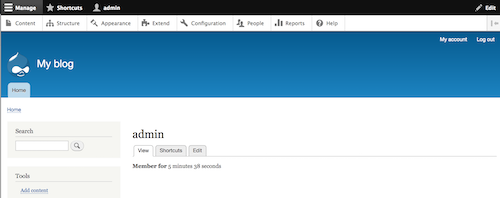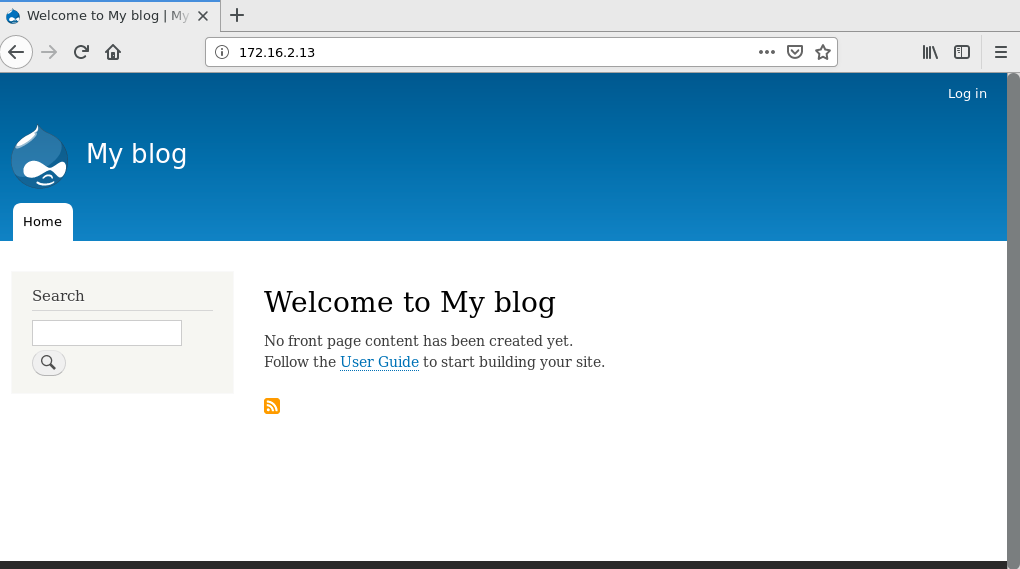Kubernetes drupal Installation (helm)
by Anish
Posted on Friday January 25, 2019

Introduction
This sample chapter extracted from the book, Kubernetes for DevOps .
Get this book on Just $9 or Ask Author for Discount
In this article we will learn how to to setup drupal in kubernetes cluster using helm
Helm: Helm is a tool for managing Kubernetes charts. Charts are packages of pre-configured Kubernetes resources.
- Lets Begin deploying drupal using helm in kubernetes , if you are new to helm then download and initialize helm as follows
root@kube-master:# helm init
root@kube-master:# kubectl create serviceaccount --namespace kube-system tiller
root@kube-master:# kubectl create clusterrolebinding tiller-cluster-rule --clusterrole=cluster-admin --serviceaccount=kube-system:tiller
root@kube-master:# kubectl patch deploy --namespace kube-system tiller-deploy -p '{"spec":{"template":{"spec":{"serviceAccount":"tiller"}}}}'
- Make sure the title-deploy pod is up and running
root@kube-master:/home/ansible# kubectl get pods -n kube-system
NAME READY STATUS RESTARTS AGE
coredns-78fcdf6894-jvmlb 1/1 Running 0 1h
coredns-78fcdf6894-xstbn 1/1 Running 0 1h
etcd-kube-master 1/1 Running 0 1h
kube-apiserver-kube-master 1/1 Running 0 1h
kube-controller-manager-kube-master 1/1 Running 0 1h
kube-flannel-ds-5gzn9 1/1 Running 0 1h
kube-flannel-ds-tlc8j 1/1 Running 0 1h
kube-proxy-kl4fg 1/1 Running 0 1h
kube-proxy-krt6n 1/1 Running 0 1h
kube-scheduler-kube-master 1/1 Running 0 1h
tiller-deploy-85744d9bfb-wh98g 1/1 Running 0 1h
- Once titler pod is up and running, deploying drupal for this we need to go and create PersistentVolume and PersistentVolumeClaim
| PersistentVolume | PersistentVolumeClaim | Purpose |
|---|---|---|
| drupal-mariadb-pv | drupal-mariadb-pvc | for storing drupal tables |
| drupal-data-pv | drupal-data-pvc | for storing druplaa files |
| drupal-apache-pv | helm will create for us | Apache files |
- Create drupal-mariadb-pv and drupal-mariadb-pvc
root@kube-master# echo "
apiVersion: v1
kind: PersistentVolume
metadata:
name: drupal-mariadb-pv
spec:
capacity:
storage: 4Gi
accessModes:
- ReadWriteOnce
- ReadOnlyMany
persistentVolumeReclaimPolicy: Retain
hostPath:
path: /data/
" | kubectl apply -f -
The drupal-mariadb-pvc
root@kube-master# echo "
kind: PersistentVolumeClaim
apiVersion: v1
metadata:
name: data-drupal-mariadb-0
spec:
storageClassName: ""
accessModes:
- ReadWriteOnce
resources:
requests:
storage: 1Gi
" | kubectl apply -f -
- create drupal-data-pv and drupal-data-pvc
root@kube-master# echo "
apiVersion: v1
kind: PersistentVolume
metadata:
name: drupal-data-pv
spec:
capacity:
storage: 1Gi
accessModes:
- ReadWriteOnce
- ReadOnlyMany
persistentVolumeReclaimPolicy: Retain
hostPath:
path: /data/drupal
" | kubectl apply -f -
The drupal-data-pvc
root@kube-master# echo "
kind: PersistentVolumeClaim
apiVersion: v1
metadata:
name: drupal-drupal-drupal
spec:
storageClassName: ""
accessModes:
- ReadWriteOnce
resources:
requests:
storage: 1Gi
" | kubectl apply -f -
- Create drupal-apache-pv
root@kube-master# echo "
kind: PersistentVolumeClaim
apiVersion: v1
metadata:
name: drupal-drupal-drupal
spec:
storageClassName: ""
accessModes:
- ReadWriteOnce
resources:
requests:
storage: 1Gi
" | kubectl apply -f -
- Verify K8 pvc bounded to correct claims
root@kube-master:# kubectl get pvc
NAME STATUS VOLUME CAPACITY ACCESS MODES STORAGECLASS AGE
data-drupal-mariadb-0 Bound drupal-mariadb-pv 4Gi RWO,ROX 18s
drupal-drupal-drupal Bound drupal-data-pv 1Gi RWO,ROX 10s
root@kube-master:# kubectl get pv
NAME CAPACITY ACCESS MODES RECLAIM POLICY STATUS CLAIM STORAGECLASS REASON AGE
drupal-apache-pv 1Gi RWO,ROX Retain Available 7s
drupal-data-pv 1Gi RWO,ROX Retain Bound default/drupal-drupal-drupal 15s
drupal-mariadb-pv 4Gi RWO,ROX Retain Bound default/data-drupal-mariadb-0 21s
- Drupal Installation starts here, this is done through helm the kubernetes package manager,
helm install --set drupalUsername=admin,drupalPassword=mydrupalpassword,mariadb.mariadbRootPassword=secretpassword,persistence.drupal.existingClaim=drupal-drupal-drupal,mariadb.enabled=true,master.persistence.existingClaim=data-drupal-mariadb-0 --name drupal stable/drupal
This will produce lot of useful resource information related to DRUPAL
NAME: drupal
LAST DEPLOYED: Fri Jan 25 16:25:21 2019
NAMESPACE: default
STATUS: DEPLOYED
RESOURCES:
==> v1/Pod(related)
NAME READY STATUS RESTARTS AGE
drupal-drupal-7965fbcbb9-kp9v7 0/1 ContainerCreating 0 3s
drupal-mariadb-0 0/1 ContainerCreating 0 3s
==> v1/Secret
NAME TYPE DATA AGE
drupal-mariadb Opaque 2 3s
drupal-drupal Opaque 1 3s
==> v1/ConfigMap
NAME DATA AGE
drupal-mariadb 1 3s
drupal-mariadb-tests 1 3s
==> v1/PersistentVolumeClaim
NAME STATUS VOLUME CAPACITY ACCESS MODES STORAGECLASS AGE
drupal-drupal-apache Bound drupal-apache-pv 1Gi RWO,ROX 3s
==> v1/Service
NAME TYPE CLUSTER-IP EXTERNAL-IP PORT(S) AGE
drupal-mariadb ClusterIP 10.97.114.226 <none> 3306/TCP 3s
drupal-drupal LoadBalancer 10.103.184.148 <pending> 80:31127/TCP,443:31178/TCP 3s
==> v1beta1/Deployment
NAME DESIRED CURRENT UP-TO-DATE AVAILABLE AGE
drupal-drupal 1 1 1 0 3s
==> v1beta1/StatefulSet
NAME DESIRED CURRENT AGE
drupal-mariadb 1 1 3s
NOTES:
*******************************************************************
*** PLEASE BE PATIENT: Drupal may take a few minutes to install ***
*******************************************************************
1. Get the Drupal URL:
NOTE: It may take a few minutes for the LoadBalancer IP to be available.
Watch the status with: 'kubectl get svc --namespace default -w drupal-drupal'
export SERVICE_IP=$(kubectl get svc --namespace default drupal-drupal --template "{{ range (index .status.loadBalancer.ingress 0) }}{{.}}{{ end }}")
echo "Drupal URL: http://$SERVICE_IP/"
2. Login with the following credentials
echo Username: admin
echo Password: $(kubectl get secret --namespace default drupal-drupal -o jsonpath="{.data.drupal-password}" | base64 --decode)
- Once the drupal POD is up and running , your drupal is not ready to use Yet , you have to be patient, depend on your network speed, it will take further 3-4 minutes
root@kube-master:# kubectl get pods
- To get your drupal admin password run
root@kube-master:# kubectl get secret --namespace default drupal-drupal -o jsonpath="{.data.drupal-password}" | base64 --decode
mydrupalpassword
- Verify the drupal service is up and running and external-ip column is no more pending
root@kube-master:/home/ansible# kubectl get svc
NAME TYPE CLUSTER-IP EXTERNAL-IP PORT(S) AGE
drupal-drupal LoadBalancer 10.103.184.148 172.16.2.13 80:31127/TCP,443:31178/TCP 3m
drupal-mariadb ClusterIP 10.97.114.226 <none> 3306/TCP 3m
kubernetes ClusterIP 10.96.0.1 <none> 443/TCP 2d
- Open the web browser and browse your loadbalancer ip

- Happy Helming and since its kubernetes you may encounter some issues, feel free to poke me
Video Demo
Thanku for reading !!! Give a Share for Support
Your Support Matters!
Instead of directly asking for donations, I'm thrilled to offer you all nine of my books for just $9 on leanpub By grabbing this bundle you not only help cover my coffee, beer, and Amazon bills but also play a crucial role in advancing and refining this project. Your contribution is indispensable, and I'm genuinely grateful for your involvement in this journey!
Any private key value that you enter or we generate is not stored on this site, this tool is provided via an HTTPS URL to ensure that private keys cannot be stolen, for extra security run this software on your network, no cloud dependency
Kubernetes Related Topics
Linux Related Topics
Ansible Related Topics
Openstack Articles
Applied Cryptography Topics
Web Crypto API Topics
python Cryptography Topics
PHP Cryptography Topics
Topics
For Coffee/ Beer/ Amazon Bill and further development of the project Support by Purchasing, The Modern Cryptography CookBook for Just $9 Coupon Price
Kubernetes for DevOps
Hello Dockerfile